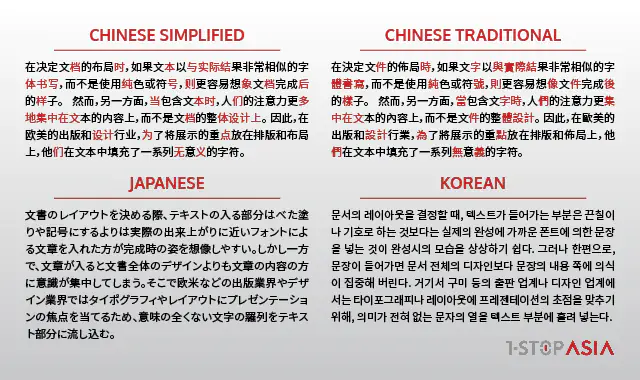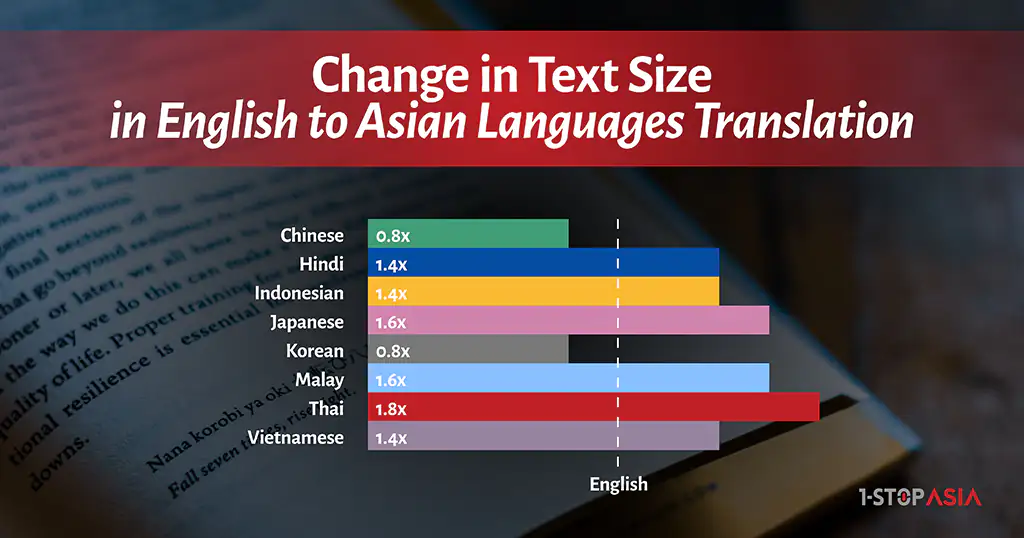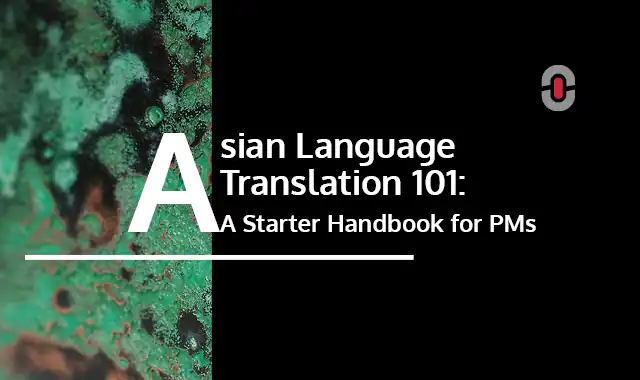Embarking on translation projects involving Asian languages can be a complex endeavor. This handbook is designed to guide project managers through this process, providing practical tips and real-world examples to navigate the unique challenges of Asian language translation efficiently.
I know that starting to work with languages you don’t understand can be challenging. This is why we’ve compiled this starter handbook to assist every PM ready to dive into the fascinating yet complicated world of Asian languages.
For you to start this journey on the right foot it’s best that you acquire a basic visual database of what the main Asian languages look like. Here’s a visual comparison between Chinese Simplified, Chinese Traditional, Japanese, and Korean (often abbreviated as CCJK).

A few important notes:
- Chinese Simplified and Chinese Traditional share many common characters, others are similar but simplified (hence the name), and others are different altogether.
- Japanese, although having its own extensive set of characters, often incorporates Chinese characters as well.
- While Korean looks similar to Chinese or Japanese (for the Westerner’s eye, that is) it is quite different since it is phonetic. The phonetic symbols (letters) are organized into blocks called syllabic blocks.
- To ascertain which language you’re dealing with you can use this table of common characters.
1. Understanding the Translation Process:
The translation process is multifaceted. Let’s break it down with examples:
- Request: The initiation of the project with detailed requirements. Begin with a detailed request. For instance, if you’re translating a website for a Chinese audience, specify whether you need Simplified or Traditional Chinese and if you need Mandarin or Cantonese.
- Preflight: Assessing and preparing the project for the translation phase. In this stage, if you’re working on a technical manual for a Japanese product, for example, ensure you have translators with technical expertise in electronics.
- Translation: The core phase where the actual translation occurs. Consider the nuances of translation, like choosing between Korean formal and informal language based on your content’s tone.
- Desktop Publishing (DTP): Formatting the translated text to match the source layout. For Hindi translations, for example, the tracking should be set to metric so you get a continuous horizontal line — with no gaps — within the words.
- Post Layout Preview (PLP): Reviewing the formatted document for any layout or textual issues.
- Delivery: Final submission of the translated content.
It’s important to note that while this is a general workflow, each project has its unique aspects and might require a tailored approach.
To look at the process from a different angle, we can separate them into the following categories:
- Linguistic: translation, editing, proofreading, back-translation, transcreation, etc.
- DTP: recreation, file preparation, DTP.
- Media: transcription, subtitle creation, voice-over, interpreting, dubbing.
A deep understanding of each phase ensures a smoother translation process and higher-quality outcomes.
2. Creating an Effective Project Request
Starting with a detailed and accurate request will ensure a smooth and quick start to the translation process. Here’s how to create one:
1. Define the language pair/s
While this sounds way too obvious, this is not always the case. A classical example of how confusing this may be is Chinese. When working with Chinese you should know whether you need Simplified or Traditional Chinese. This relates to the script the text is written with. Then you need to define whether you need Mandarin or Cantonese (those are the most common, but Chinese has many more dialects, and many of them are mutually unintelligible). To help you out with this one we prepared this handy cheat sheet.
2. Choose the best service to suit your project
In order to choose the best service for your project, it’s important to understand the specific needs of your content and audience. Here’s a brief guideline:
- Translation vs. Transcreation: For marketing or creative content, consider transcreation, which involves culturally adapting the content for the target audience, rather than a direct translation.
- Technical vs. General Translation: Technical documents require translators with subject matter expertise. In contrast, general translations are suitable for non-specialized content.
- Subtitling and Dubbing for Media: If your project involves media, determine whether subtitling or dubbing is more appropriate, considering your audience’s preferences and the content type.
Selecting the right service is crucial for meeting your project’s specific needs.
3. Measure the volume accurately
Accurate volume measurement is crucial for an effective quote. In translation, volume is typically measured in words or characters. However, Asian languages can present unique challenges:
- Character-Based Languages: For languages like Chinese and Japanese, character count is a more relevant metric than word count.
- Expansion and Contraction: Some languages expand or contract when translated. The [infographic] below provides data on how text length can vary between Asian languages and English, which is essential for planning and budgeting.
Utilize tools like our Weighted Word Count Calculator to accurately estimate the volume of your project, considering factors such as repetitions and non-translatable elements. Accurate volume measurement is crucial for budgeting and planning.

4. Calculate the deadline
Setting a realistic deadline is pivotal for the smooth execution of your project. Consider the following:
- Complexity of the Task: Tasks like DTP and transcreation take longer than straightforward translations.
- Language Pair and Availability of Resources: Some language pairs might have fewer available translators, impacting turnaround time.
- Volume and Content Type: Larger volumes and technical content require more time.
Incorporate buffer time for quality checks and unexpected delays. Use project management tools and historical data to estimate timelines more accurately.
This framework provides a solid foundation for project managers navigating the complexities of working with Asian languages. Each project is unique, so adapt these guidelines to fit the specific needs of your project.
Final Thoughts
While this guide provides a basic introduction to working with Asian languages, there are many more intricacies and specifics we will cover in future articles. Feel free to reach out to our experts to discuss your specific project needs.
Special thanks to my colleagues Kiril Kulev, Nadezhda Kavrakova, and Rosen Ivanov for sharing their expertise and insights.
